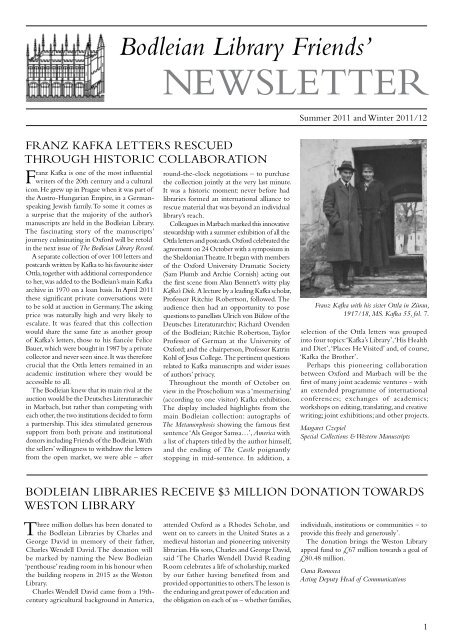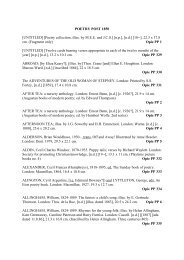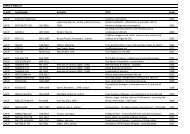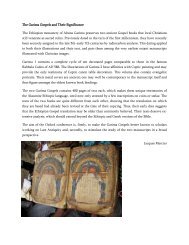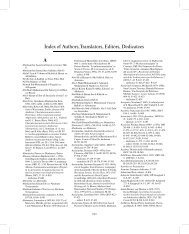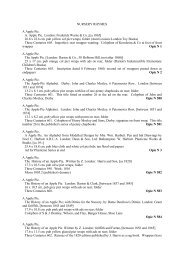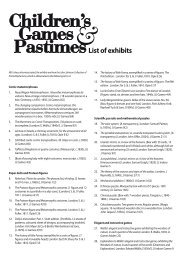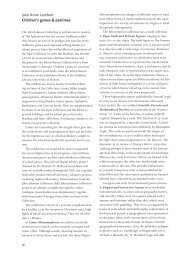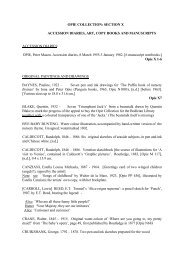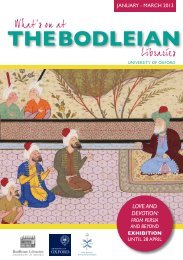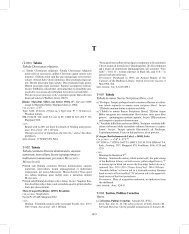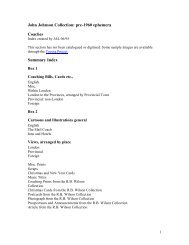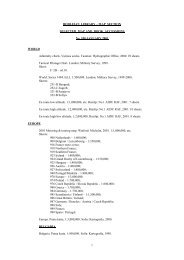NEWSLETTER - Bodleian Libraries - University of Oxford
NEWSLETTER - Bodleian Libraries - University of Oxford
NEWSLETTER - Bodleian Libraries - University of Oxford
You also want an ePaper? Increase the reach of your titles
YUMPU automatically turns print PDFs into web optimized ePapers that Google loves.
Franz Kafka is one <strong>of</strong> the most influential<br />
writers <strong>of</strong> the 20th century and a cultural<br />
icon. He grew up in Prague when it was part <strong>of</strong><br />
the Austro-Hungarian Empire, in a Germanspeaking<br />
Jewish family. To some it comes as<br />
a surprise that the majority <strong>of</strong> the author’s<br />
manuscripts are held in the <strong>Bodleian</strong> Library.<br />
The fascinating story <strong>of</strong> the manuscripts’<br />
journey culminating in <strong>Oxford</strong> will be retold<br />
in the next issue <strong>of</strong> The <strong>Bodleian</strong> Library Record.<br />
A separate collection <strong>of</strong> over 100 letters and<br />
postcards written by Kafka to his favourite sister<br />
Ottla, together with additional correspondence<br />
to her, was added to the <strong>Bodleian</strong>’s main Kafka<br />
archive in 1970 on a loan basis. In April 2011<br />
these significant private conversations were<br />
to be sold at auction in Germany. The asking<br />
price was naturally high and very likely to<br />
escalate. It was feared that this collection<br />
would share the same fate as another group<br />
<strong>of</strong> Kafka’s letters, those to his fiancée Felice<br />
Bauer, which were bought in 1987 by a private<br />
collector and never seen since. It was therefore<br />
crucial that the Ottla letters remained in an<br />
academic institution where they would be<br />
accessible to all.<br />
The <strong>Bodleian</strong> knew that its main rival at the<br />
auction would be the Deutsches Literaturarchiv<br />
in Marbach, but rather than competing with<br />
each other, the two institutions decided to form<br />
a partnership. This idea stimulated generous<br />
support from both private and institutional<br />
donors including Friends <strong>of</strong> the <strong>Bodleian</strong>. With<br />
the sellers’ willingness to withdraw the letters<br />
from the open market, we were able – after<br />
<strong>Bodleian</strong> Library Friends’<br />
<strong>NEWSLETTER</strong><br />
FRANZ KAFKA LETTERS RESCUED<br />
THROUGH HISTORIC COLLABORATION<br />
round-the-clock negotiations – to purchase<br />
the collection jointly at the very last minute.<br />
It was a historic moment: never before had<br />
libraries formed an international alliance to<br />
rescue material that was beyond an individual<br />
library’s reach.<br />
Colleagues in Marbach marked this innovative<br />
stewardship with a summer exhibition <strong>of</strong> all the<br />
Ottla letters and postcards. <strong>Oxford</strong> celebrated the<br />
agreement on 24 October with a symposium in<br />
the Sheldonian Theatre. It began with members<br />
<strong>of</strong> the <strong>Oxford</strong> <strong>University</strong> Dramatic Society<br />
(Sam Plumb and Archie Cornish) acting out<br />
the first scene from Alan Bennett’s witty play<br />
Kafka’s Dick. A lecture by a leading Kafka scholar,<br />
Pr<strong>of</strong>essor Ritchie Robertson, followed. The<br />
audience then had an opportunity to pose<br />
questions to panellists Ulrich von Bülow <strong>of</strong> the<br />
Deutsches Literaturarchiv; Richard Ovenden<br />
<strong>of</strong> the <strong>Bodleian</strong>; Ritchie Robertson, Taylor<br />
Pr<strong>of</strong>essor <strong>of</strong> German at the <strong>University</strong> <strong>of</strong><br />
<strong>Oxford</strong>; and the chairperson, Pr<strong>of</strong>essor Katrin<br />
Kohl <strong>of</strong> Jesus College. The pertinent questions<br />
related to Kafka manuscripts and wider issues<br />
<strong>of</strong> authors’ privacy.<br />
Throughout the month <strong>of</strong> October on<br />
view in the Proscholium was a ‘mesmerising’<br />
(according to one visitor) Kafka exhibition.<br />
The display included highlights from the<br />
main <strong>Bodleian</strong> collection: autographs <strong>of</strong><br />
The Metamorphosis showing the famous first<br />
sentence ‘Als Gregor Samsa…’, America with<br />
a list <strong>of</strong> chapters titled by the author himself,<br />
and the ending <strong>of</strong> The Castle poignantly<br />
stopping in mid-sentence. In addition, a<br />
Summer 2011 and Winter 2011/12<br />
Franz Kafka with his sister Ottla in Zürau,<br />
1917/18, MS. Kafka 55, fol. 7.<br />
selection <strong>of</strong> the Ottla letters was grouped<br />
into four topics: ‘Kafka’s Library’, ‘His Health<br />
and Diet’, ‘Places He Visited’ and, <strong>of</strong> course,<br />
‘Kafka the Brother’.<br />
Perhaps this pioneering collaboration<br />
between <strong>Oxford</strong> and Marbach will be the<br />
first <strong>of</strong> many joint academic ventures - with<br />
an extended programme <strong>of</strong> international<br />
conferences; exchanges <strong>of</strong> academics;<br />
workshops on editing, translating, and creative<br />
writing; joint exhibitions; and other projects.<br />
Margaret Czepiel<br />
Special Collections & Western Manuscripts<br />
BODLEIAN LIBRARIES RECEIVE $3 MILLION DONATION TOWARDS<br />
WESTON LIBRARY<br />
Three million dollars has been donated to<br />
the <strong>Bodleian</strong> <strong>Libraries</strong> by Charles and<br />
George David in memory <strong>of</strong> their father,<br />
Charles Wendell David. The donation will<br />
be marked by naming the New <strong>Bodleian</strong><br />
‘penthouse’ reading room in his honour when<br />
the building reopens in 2015 as the Weston<br />
Library.<br />
Charles Wendell David came from a 19thcentury<br />
agricultural background in America,<br />
attended <strong>Oxford</strong> as a Rhodes Scholar, and<br />
went on to careers in the United States as a<br />
medieval historian and pioneering university<br />
librarian. His sons, Charles and George David,<br />
said ‘The Charles Wendell David Reading<br />
Room celebrates a life <strong>of</strong> scholarship, marked<br />
by our father having benefited from and<br />
provided opportunities to others. The lesson is<br />
the enduring and great power <strong>of</strong> education and<br />
the obligation on each <strong>of</strong> us – whether families,<br />
individuals, institutions or communities – to<br />
provide this freely and generously’.<br />
The donation brings the Weston Library<br />
appeal fund to £67 million towards a goal <strong>of</strong><br />
£80.48 million.<br />
Oana Romocea<br />
Acting Deputy Head <strong>of</strong> Communications<br />
1
NEW BODLEIAN CLOSES ITS DOORS AFTER 70 YEARS<br />
At the end <strong>of</strong> July 2011 the New <strong>Bodleian</strong><br />
in its present guise was closed permanently<br />
following more than 70 years <strong>of</strong> service to<br />
the <strong>University</strong>. Over the next three years the<br />
building will undergo major renovation and<br />
redevelopment, and will reopen as the Weston<br />
Library in 2015.<br />
Known to readers, scholars, visitors, and the<br />
<strong>Oxford</strong> community as a book fortress housing<br />
more than 3 million books, 1 million maps,<br />
1.5 million items <strong>of</strong> ephemera, and 10,000<br />
medieval manuscripts, the New <strong>Bodleian</strong> has<br />
been in major need <strong>of</strong> transformation and<br />
upgrading.<br />
The closing down was marked by a<br />
celebration in the New <strong>Bodleian</strong> Reading<br />
Room, the same room where the opening<br />
ceremony attended by King George VI took<br />
place in 1946. The event was attended by over<br />
150 staff members new and old, including Roy<br />
Beesley who began working at the <strong>Bodleian</strong><br />
in 1934, before the New Library was built.<br />
Dr Sarah Thomas, Bodley’s Librarian, quoted<br />
in her speech from a report written by one<br />
<strong>of</strong> her predecessors, Sir Edmund Craster, who<br />
had developed the detailed plans for a new<br />
library building, and had commissioned the<br />
architect Giles Gilbert Scott to design it:<br />
‘To replace an old library by an entirely new<br />
one is a comparatively simple matter. But to<br />
retain and transform the old and add to it<br />
a great new library building is much more<br />
complex’. These words are still true today, as<br />
the Library management have spent the last<br />
six years planning for the transformation <strong>of</strong><br />
the New <strong>Bodleian</strong>.<br />
Dr Thomas went on to thank the donors<br />
and supporters who have contributed to<br />
the renovation project, the large number <strong>of</strong><br />
<strong>University</strong> staff who have been involved in<br />
preparing the building for renovation, and the<br />
Library staff who helped empty the building<br />
and ‘endured disruption <strong>of</strong> their workplaces,<br />
work processes, and the materials they work<br />
with, whether print, manuscript, or electronic’.<br />
The event ended with a piper escorting<br />
Bodley’s Librarian and the newly-acquired<br />
manuscript <strong>of</strong> Jane Austen’s The Watsons as<br />
the final item to leave the building.<br />
To mark the event, the <strong>Bodleian</strong> has also<br />
launched a public appeal (published in The<br />
<strong>Oxford</strong> Times) for people who were associated<br />
with the New <strong>Bodleian</strong> to come forward with<br />
their memories. If you or someone you know<br />
recalls memories <strong>of</strong> the New <strong>Bodleian</strong>, the<br />
Library would like to hear from you. Please<br />
send an email to Oana Romocea at oana.<br />
romocea@bodleian.ox.ac.uk or call her on<br />
01865 277627.<br />
Oana Romocea<br />
Acting Deputy Head <strong>of</strong> Communications<br />
Large road crane installs pieces <strong>of</strong> a more<br />
permanent crane inside the New <strong>Bodleian</strong>.<br />
Photo by Nick Cistone.<br />
THE GLADSTONE LINK (PREVIOUSLY UNDERGROUND BOOKSTORE)<br />
The Gladstone Link is a new area <strong>of</strong> the<br />
<strong>Bodleian</strong> Library for open-shelf library<br />
material accessible to readers, the first in these<br />
buildings since 1912. There is shelf space for an<br />
additional 270,000 items, roughly doubling the<br />
open shelf provision in the <strong>Bodleian</strong> Library to<br />
around 500,000. The Library has also taken the<br />
opportunity to link the Old <strong>Bodleian</strong> Library<br />
and the Radcliffe Camera, connecting the<br />
reading rooms for the first time, and to create<br />
120 extra reader spaces, as well as facilities<br />
such as reader terminals and photocopiers.<br />
The entrance to the Gladstone Link is via<br />
the North Staircase <strong>of</strong> the Old <strong>Bodleian</strong><br />
or via the Lower Camera Reading Room<br />
in the Radcliffe Camera. In the Gladstone<br />
Link readers can orientate themselves by<br />
remembering that the blue wall represents ‘B’<br />
for <strong>Bodleian</strong> and the red wall represents ‘R’<br />
for Radcliffe Camera. Redevelopment <strong>of</strong> the<br />
Underground Bookstore into the Gladstone<br />
Link has been made possible by the decision<br />
to remove low-usage books to the Book<br />
Storage Facility in Swindon. This has freed<br />
up space for more open-shelf material and<br />
provided an additional 1,674 square metres<br />
<strong>of</strong> space in what was previously the old<br />
Underground Bookstore. The <strong>Libraries</strong> have<br />
2<br />
analysed bookstack requests and other data to<br />
ensure that the most requested items that have<br />
been fetched for readers by staff are moved<br />
to open shelves.<br />
The Underground Bookstore was built<br />
between 1909 and 1912 as an overflow<br />
book storage facility on two floors. The<br />
refurbishment has been designed to respect the<br />
architectural heritage <strong>of</strong> the space, providing a<br />
mixture <strong>of</strong> fixed and mobile shelving capable<br />
<strong>of</strong> housing 270,000 books and <strong>of</strong>fering<br />
informal study areas for readers. The plan<br />
preserves as a historic display a proportion<br />
<strong>of</strong> the Gladstone bookshelves which were<br />
originally manufactured at the local Eagle<br />
Ironworks in Jericho, <strong>Oxford</strong>, and used on<br />
the main level <strong>of</strong> the bookstore. These shelves,<br />
which are designed to hang on rollers from<br />
the beams or the ro<strong>of</strong> frame, were so called<br />
because they were suggested by W. E. Gladstone,<br />
Victorian Liberal Prime Minister and <strong>Oxford</strong><br />
graduate. The refurbished area and the tunnel<br />
will be known collectively as the Gladstone<br />
Link in his honour.<br />
Oana Romocea<br />
Acting Deputy Head <strong>of</strong> Communications<br />
Section <strong>of</strong> the Gladstone Link.
FIHRIST – THE GATEWAY TO ISLAMIC MANUSCRIPTS<br />
British institutions preserve important<br />
collections <strong>of</strong> Islamic manuscripts<br />
including many early and rare items. To<br />
date these collections have been relatively<br />
inaccessible and do not get the exposure they<br />
deserve as information about them can be scant<br />
or only available in old printed catalogues,<br />
some <strong>of</strong> which were written in Latin.<br />
In late 2009, following on from a successful<br />
bid as part <strong>of</strong> the Joint Information Systems<br />
Committee’s (JISC) Islamic Studies<br />
Programme, the <strong>Bodleian</strong> <strong>Libraries</strong> and<br />
Cambridge <strong>University</strong> Library embarked upon<br />
a groundbreaking joint project to create an<br />
online catalogue <strong>of</strong> their Islamic manuscript<br />
collections. The <strong>Oxford</strong> and Cambridge<br />
Islamic Manuscripts Catalogue Online<br />
BODLEIAN ITEMS INSCRIBED ON UNESCO REGISTER<br />
On 23 May 2011 two items from the<br />
<strong>Bodleian</strong> were inscribed on the UK<br />
Memory <strong>of</strong> the World Register: the Gough<br />
Map and the manuscript <strong>of</strong> Cura Pastoralis.<br />
UNESCO established the Memory <strong>of</strong> the<br />
World Programme in 1992. Impetus came<br />
originally from a growing awareness <strong>of</strong> the<br />
parlous state <strong>of</strong> preservation <strong>of</strong>, and access to,<br />
documentary heritage in various parts <strong>of</strong> the<br />
world. War and social upheaval, as well as severe<br />
lack <strong>of</strong> resources, have worsened problems<br />
which have existed for centuries. Significant<br />
collections worldwide have suffered a variety<br />
<strong>of</strong> fates. Looting and dispersal, illegal trading,<br />
destruction, inadequate housing and funding<br />
have all played a part. Much has vanished<br />
forever; much is endangered.<br />
Both collections and individual documents<br />
may be inscribed on the Register. Since its<br />
establishment a further strand has developed <strong>of</strong><br />
material not under threat, but significant for its<br />
influence on human thought and life, or for its<br />
iconic status representing important moments<br />
or stages in history or culture. The Magna<br />
Carta is an example – the four surviving 1215<br />
engrossments are inscribed on the Register<br />
in recognition <strong>of</strong> the enormous influence<br />
the document has had on the development<br />
<strong>of</strong> human liberty.<br />
National registers have been established in<br />
many countries (and some world regions);<br />
they recognise the significance <strong>of</strong> documents<br />
whose influence has been national rather than<br />
international. The UK register was inaugurated<br />
in 2010, and the <strong>Bodleian</strong>’s inscriptions formed<br />
part <strong>of</strong> the second round <strong>of</strong> inscriptions.<br />
(OCIMCO) project teams used a TEI/XML<br />
schema to convert printed catalogue records <strong>of</strong><br />
nearly 10,000 separate works in Arabic, Persian,<br />
and Turkish, and create a searchable online<br />
database <strong>of</strong> these works. <strong>Oxford</strong> created nearly<br />
5,000 online records <strong>of</strong> its Arabic manuscripts<br />
based on the old catalogue cards, which were<br />
previously only available in the <strong>Bodleian</strong>’s<br />
Oriental reading room. Cambridge converted<br />
information in existing printed catalogues<br />
into around 5,000 online records. Launched<br />
in February 2011, the resulting website<br />
www.fihrist.org.uk/ was named Fihrist after the<br />
famous Kitāb al-Fihrist, the catalogue <strong>of</strong> Ibn<br />
Nadīm, a bookseller in 10th-century Baghdad,<br />
containing a list <strong>of</strong> every book known to<br />
him. Further JISC funding in 2011 allowed<br />
King Alfred’s translation from the Latin <strong>of</strong><br />
Gregory’s Cura Pastoralis (‘Pastoral Care’) is<br />
a manuscript dating from around 890, and is<br />
the earliest surviving book written entirely in<br />
the English language. It can be linked directly<br />
with King Alfred as it is his translation from<br />
the Latin into Anglo-Saxon and bears a unique<br />
and salutary preface about the decline <strong>of</strong><br />
learning among his people, in the form <strong>of</strong> a<br />
letter from the King to Waerferth, Bishop <strong>of</strong><br />
Worcester. The book was prepared with great<br />
rhetorical sophistication at a crucial time in the<br />
nation’s political and cultural development as<br />
an instrument to consolidate learning and to<br />
forge national identity. Alfred sent copies <strong>of</strong><br />
his translation (prepared by pr<strong>of</strong>essional scribes<br />
rather than written out by the King himself)<br />
to each <strong>of</strong> his bishops and it is supposed that<br />
he included with them an aestel, or pointer<br />
to follow text – a famous jewelled example is<br />
one <strong>of</strong> the Ashmolean Museum’s great treasures,<br />
the ‘Alfred jewel’.<br />
The Gough Map, dated to the 14th century,<br />
is the most important and most enigmatic<br />
cartographic representation <strong>of</strong> Great Britain<br />
from the medieval period. It is the earliest<br />
surviving route map <strong>of</strong> Britain, and the<br />
earliest surviving map depicting Britain<br />
with a recognisable coastline. It depicts over<br />
600 towns and villages. Despite the wealth<br />
<strong>of</strong> information conveyed by the map, little<br />
is known <strong>of</strong> its creation, its purpose or its<br />
intended audience. The map’s allure has long<br />
attracted the attention <strong>of</strong> a broad range <strong>of</strong><br />
interested parties, ranging from the academic<br />
community to genealogists. There is no record<br />
Fihrist to become multi-institutional and<br />
develop into the ‘gateway to manuscripts in<br />
the Arabic script’, and to date there are eight<br />
contributing institutions including the British<br />
Library and the Royal Asiatic Society. Fihrist is<br />
continuing to develop and expand, and, thanks<br />
to a grant from the Barakat Trust, a project to<br />
add <strong>Oxford</strong>’s Persian manuscript records to<br />
Fihrist is currently underway; and it is a longterm<br />
goal <strong>of</strong> Fihrist to provide digital images<br />
<strong>of</strong> the manuscripts for which catalogue records<br />
are now publicly available.<br />
Alasdair Watson<br />
Middle Eastern & Islamic Manuscripts<br />
<strong>of</strong> any similar medieval map at such scale or<br />
accuracy. Though we know nothing <strong>of</strong> the<br />
map’s history before the late 18th century,<br />
it clearly became internationally influential<br />
in cartographic depictions <strong>of</strong> Britain in the<br />
early modern period, informing among others<br />
Sebastian Münster’s edition <strong>of</strong> Ptolemy’s<br />
Geographia (Basle, 1540) and Mercator’s Angliae,<br />
Scotiae & Hiberniae Nova Descriptio (Duisburg,<br />
1564).<br />
Michael Heaney<br />
Executive Secretary, <strong>Bodleian</strong> <strong>Libraries</strong><br />
United Nations<br />
Educational, Scientific and<br />
Cultural Organization<br />
Cura Pastoralis<br />
Inscribed on the UK Register in 2011<br />
Memory <strong>of</strong> the World<br />
3
JANE AUSTEN’S THE WATSONS<br />
On 14 July 2011 the <strong>Bodleian</strong> Library<br />
acquired at auction at Sotheby’s, London,<br />
the only known fiction manuscript in Jane<br />
Austen’s hand still in private ownership. The<br />
manuscript had descended from Austen’s sister<br />
Cassandra to her niece Caroline Austen, and<br />
it was in Caroline’s possession when first<br />
published in 1871 by her brother James Edward<br />
Austen-Leigh, who named it The Watsons. In<br />
1915 Caroline’s nephew, William Austen-Leigh,<br />
caused some dismay in the family when he<br />
divided the manuscript, presenting the first<br />
six leaves to a charity sale in aid <strong>of</strong> the Red<br />
Cross Society. This portion was subsequently<br />
acquired in 1925 by the Morgan Library, New<br />
York, where it remains. The larger portion<br />
was in Austen-Leigh family ownership until<br />
1978 when it was sold, first to the British<br />
Rail Pension Fund and again in 1988 to a<br />
private bidder.<br />
Probably drafted in Bath in 1804-5, The<br />
Watsons marked a decisive turning point in<br />
the kind <strong>of</strong> fiction Jane Austen was writing<br />
– towards a darker and more realistic style <strong>of</strong><br />
social criticism. Though never completed for<br />
publication, material from it was redeployed,<br />
notably into Mansfield Park. In aesthetic terms,<br />
the <strong>Bodleian</strong> manuscript is <strong>of</strong> immense value:<br />
4<br />
RECENT ACQUISITIONS<br />
This album <strong>of</strong> Byroniana was kept from<br />
around 1805 by members <strong>of</strong> the Parkyn<br />
family, including Frances Parkyn (‘Miss<br />
Frances’) who has the distinction <strong>of</strong> being<br />
mentioned by Byron in the first letter in<br />
volume one <strong>of</strong> Byron’s Letters and Journals edited<br />
by Leslie A. Marchand (London: John Murray,<br />
1973). The poet writes from Newstead Abbey<br />
on 8 November 1798 to his aunt Charlotte<br />
Parker: ‘I have sent a young Rabbit which I<br />
beg Miss Frances will accept <strong>of</strong>f and which I<br />
promised to send before’.<br />
It was with the Parkyn family that Byron<br />
stayed in Nottingham while he was being<br />
tutored and while his foot was being doctored<br />
by the quack Lavender. Frances and her sister<br />
Margaret apparently fell in love with Byron<br />
and later wrote him many letters (now in the<br />
John Murray Archive at the National Library<br />
<strong>of</strong> Scotland). The album includes Byron poems<br />
with variants; poems by Frances, responding<br />
to poems by Byron; various souvenirs from<br />
Newstead, given to her by Byron himself,<br />
including leaves from trees on the estate. There<br />
are also notes, cuttings, and other material<br />
68 pages <strong>of</strong> closely written text, filled<br />
with deletions and revisions, it represents<br />
Austen’s extant draft <strong>of</strong> a novel in process<br />
<strong>of</strong> development. There are no manuscripts<br />
for her famous six novels.<br />
Not only <strong>of</strong> interest for its linguistic<br />
text (its words), The Watsons also <strong>of</strong>fers<br />
a unique opportunity to study Austen’s<br />
method <strong>of</strong> making homemade booklets<br />
as her usual writing surface. Formed <strong>of</strong><br />
a series <strong>of</strong> nine small four-leaf booklets,<br />
cut down and folded from larger sheets,<br />
the tightly structured manuscript literally<br />
demonstrates the famous economy <strong>of</strong> her<br />
art at the physical level.<br />
With its purchase by the <strong>Bodleian</strong><br />
Library, made with the assistance <strong>of</strong> the<br />
Friends <strong>of</strong> the <strong>Bodleian</strong>, The Watsons is<br />
at last held for the nation. It joins the<br />
juvenile notebook, ‘Volume the First’,<br />
making the <strong>Bodleian</strong>’s one <strong>of</strong> the foremost<br />
collections <strong>of</strong> Austen’s manuscripts in<br />
the world.<br />
Pr<strong>of</strong>essor Kathryn Sutherland<br />
St Anne’s College, <strong>Oxford</strong><br />
BYRON COMMONPLACE BOOK<br />
relating to Byron’s mother. The<br />
album is one <strong>of</strong> the earliest<br />
examples <strong>of</strong> captured Byron<br />
‘trophies’, for which there was<br />
extraordinary competition<br />
among Regency ladies.<br />
The volume featured in<br />
the recent Duke Humfrey’s<br />
Night and attracted a number<br />
<strong>of</strong> donations. Friends <strong>of</strong> the<br />
<strong>Bodleian</strong> completed the<br />
purchase.<br />
Dr Christopher Fletcher<br />
Keeper <strong>of</strong> Special Collections<br />
Page from the commonplace<br />
book <strong>of</strong> Byroniana.<br />
Page from the manuscript <strong>of</strong> Jane Austen’s<br />
The Watsons, MS. Eng. e. 3764.
JOHN LE CARRÉ<br />
The award-winning novelist John le<br />
Carré has deposited his archive in the<br />
<strong>Bodleian</strong> Library, with the intention that it<br />
should become its permanent home in lieu<br />
<strong>of</strong> death duties in the fullness <strong>of</strong> time. ‘I am<br />
delighted to be able to do this,’ le Carré writes,<br />
‘<strong>Oxford</strong> was Smiley’s spiritual home, as it is<br />
mine. And while I have the greatest respect for<br />
American universities, the <strong>Bodleian</strong> is where I<br />
shall most happily rest’. Almost 500 boxes <strong>of</strong><br />
literary papers have already arrived and been<br />
catalogued, and to mark the occasion a selection<br />
<strong>of</strong> manuscripts, books, and photographs was<br />
displayed to members <strong>of</strong> the public in the<br />
Divinity School for World Book Day on 3<br />
March 2011. Three <strong>of</strong> le Carré’s own favourite<br />
novels were featured – Tinker Tailor Soldier Spy<br />
(1974), The Tailor <strong>of</strong> Panama (1996), and The<br />
Constant Gardener (2001) – with the Tinker<br />
Tailor material proving particularly popular<br />
in the run-up to the September release <strong>of</strong><br />
the film starring Gary Oldman. Multiple<br />
manuscript drafts <strong>of</strong> the novel reveal that it<br />
was extensively rewritten during the course <strong>of</strong><br />
composition and that one <strong>of</strong> its original titles<br />
was ‘The Reluctant Autumn <strong>of</strong> George Smiley’.<br />
Also on display were le Carré’s ‘Tools <strong>of</strong> the<br />
Trade’, including his famous Parker Du<strong>of</strong>old<br />
pen; a pair <strong>of</strong> scissors and a stapler, which he<br />
uses to cut and fasten his<br />
amended handwritten and<br />
typed drafts together; and<br />
a well-padded cushion on<br />
which to rest his arm while<br />
writing.<br />
John le Carré is the<br />
pseudonym <strong>of</strong> David John<br />
Moore Cornwell. Born in<br />
1931 he was educated at<br />
Sherborne School and<br />
the universities <strong>of</strong> Berne<br />
and <strong>Oxford</strong>, where he<br />
read Modern Languages<br />
at Lincoln College. While<br />
he was working for the<br />
British Foreign Service in<br />
Germany he wrote The<br />
Spy Who Came in from the<br />
Cold (1963), the success<br />
<strong>of</strong> which enabled him to<br />
become a full-time writer.<br />
He is currently the author<br />
<strong>of</strong> 22 novels and patron<br />
<strong>of</strong> The Constant Gardener<br />
Charitable Trust.<br />
Dr Judith Priestman<br />
Special Collections & Western Manuscripts<br />
EXHIBITIONS AND OTHER LIBRARY EVENTS<br />
TREASURES OF THE BODLEIAN<br />
30 SEPTEMBER – 23 DECEMBER 2011<br />
In a letter written in Egypt in the 2nd or 3rd<br />
century AD a boy complains to his father:<br />
‘If you don’t send for me, I shan’t eat, I shan’t<br />
drink. So there!’ In a 16th-century manuscript<br />
an Aztec bride and groom sit facing each<br />
other on their wedding night, their clothes<br />
ceremonially knotted together. In a medieval<br />
bestiary a dragon coils itself around an elephant.<br />
A wireless operator’s log records the faint, final<br />
signals from the stricken Titanic: ‘Sinking We<br />
are putting passengers and ------ <strong>of</strong>f in small<br />
boats ------ weather clear’. These are some <strong>of</strong><br />
the remarkable items visitors were able to see<br />
in this year’s winter exhibition.<br />
Treasures <strong>of</strong> the <strong>Bodleian</strong> rehearsed ways in<br />
which the permanent exhibition gallery in<br />
the Weston Library might be arranged when it<br />
opens in 2015. Suggestions were invited from<br />
all members <strong>of</strong> staff, curators were consulted,<br />
and after due deliberation 70 exhibits were<br />
selected from the 9 million items in the<br />
<strong>Bodleian</strong> <strong>Libraries</strong>. Dating from the 1st century<br />
AD to 2002, and originating from diverse<br />
parts <strong>of</strong> the world, these items were grouped<br />
into broad themes: ‘The Classical Heritage’,<br />
‘Maps and Boundaries’, ‘The Sacred Word’,<br />
‘The Animal Kingdom’, ‘The Plant Kingdom’,<br />
‘Foul Papers and Fair Copies’, ‘Scientific<br />
Observation’, ‘Mathematics’, ‘Moments in<br />
History’, and ‘The <strong>University</strong> and its Library’.<br />
A few books and<br />
manuscripts were always<br />
going to be included in<br />
the exhibition – celebrated<br />
treasures such as Magna<br />
Carta, the First Folio <strong>of</strong><br />
Shakespeare’s plays, and<br />
the Gutenberg Bible. They<br />
were joined by books,<br />
manuscripts, maps, and<br />
objects notable for their<br />
beauty, their age, their<br />
scholarly importance,<br />
together with more<br />
unexpected items, such<br />
as an admission ticket<br />
for the great Suffragette<br />
gathering in Hyde Park<br />
in 1908, and the first ten<br />
Penguin books. Choosing<br />
one treasure over another<br />
is, inevitably, a subjective<br />
business, and visitors to<br />
the exhibition have been<br />
invited to <strong>of</strong>fer their<br />
own views. The debate<br />
continues on the accompanying website:<br />
treasures.bodleian.ox.ac.uk.<br />
Stephen Hebron<br />
Curator, Treasures <strong>of</strong> the <strong>Bodleian</strong><br />
John le Carré, 2009.<br />
Detail from The Ashmole Bestiary,<br />
MS. Ashmole 1511, fol. 78v.<br />
5
MANIFOLD GREATNESS: OXFORD AND THE MAKING OF THE<br />
KING JAMES BIBLE<br />
22 APRIL – 4 SEPTEMBER 2011<br />
<strong>Oxford</strong> has a long tradition <strong>of</strong> Bible<br />
translation and publication, and so the<br />
<strong>Bodleian</strong> was delighted to be able to play<br />
an important role in the celebrations <strong>of</strong> the<br />
400th anniversary <strong>of</strong> the publication <strong>of</strong> the<br />
King James Bible during 2011 by means<br />
<strong>of</strong> its exhibition, Manifold Greatness: <strong>Oxford</strong><br />
and the Making <strong>of</strong> the King James Bible, which<br />
ran from April to September and welcomed<br />
a record-breaking 58,000 visitors. The<br />
exhibition provided a rare opportunity for<br />
members <strong>of</strong> the public to encounter the key<br />
surviving materials that bear witness to the<br />
process <strong>of</strong> translation, such as the <strong>Bodleian</strong><br />
Bishops’ Bible that contains annotations from<br />
the translators’ work, and John Bois’s notes<br />
(loaned by Corpus Christi College) that record<br />
the discussions over the final version <strong>of</strong> the<br />
translation. The rich holdings <strong>of</strong> the <strong>Bodleian</strong><br />
in medieval Biblical works and translations<br />
also enabled visitors to learn more about the<br />
roots <strong>of</strong> the King James Bible in earlier times<br />
by displaying treasures such as MS. Junius 11,<br />
OXFORD LITERARY FESTIVAL<br />
In the spring <strong>of</strong> 2012 the <strong>Bodleian</strong> Library<br />
will enter the decennial season as co-host<br />
<strong>of</strong> The Sunday Times <strong>Oxford</strong> Literary Festival.<br />
Our support for this major event in the Library<br />
calendar commenced in April 2003 and has<br />
progressively grown in scale and stature, as<br />
in recent years we have worked to increase<br />
the pr<strong>of</strong>ile <strong>of</strong> the Library and access to it. In<br />
keeping with previous years we plan to play<br />
host for two days <strong>of</strong> the Festival. The words<br />
<strong>of</strong> Chris Fletcher during the 2009 festival<br />
perfectly explain the part we play in it: ‘The<br />
<strong>Bodleian</strong> is keen to work with the <strong>Oxford</strong><br />
Literary Festival to introduce a wide audience<br />
<strong>of</strong> festival goers to its spectacular collections,<br />
beautiful buildings and knowledgeable staff.<br />
Where possible we try to host events that<br />
have some special significance in terms <strong>of</strong> the<br />
Library’s holdings’. Sessions are staged in the<br />
Divinity School and there is an opportunity<br />
to see even more <strong>of</strong> our historic spaces on<br />
our popular behind-the-scenes tours (Duke<br />
Humfrey’s Library and Radcliffe Camera). The<br />
6<br />
a unique Anglo-Saxon manuscript containing<br />
poems on Biblical themes, and examples <strong>of</strong><br />
the Wycliffite Bible translation <strong>of</strong> the late 14th<br />
century and the early 16th-century version by<br />
William Tyndale.<br />
A unique element in the <strong>Bodleian</strong> exhibition<br />
was the display <strong>of</strong> archival material and books<br />
relating to the translators who comprised the<br />
two translating committees that met in <strong>Oxford</strong><br />
at Merton and Corpus Christi Colleges (four<br />
other committees met in Cambridge and<br />
Westminster). Of particular significance in this<br />
regard were John Rainolds and Henry Savile,<br />
whose wide intellectual interests were amply<br />
represented in the exhibition.<br />
Manifold Greatness welcomed visitors from<br />
across the globe and the local area, and was the<br />
subject <strong>of</strong> generous coverage in The <strong>Oxford</strong><br />
Times and on local TV and radio stations.<br />
Dr Helen Moore<br />
Corpus Christi College, <strong>Oxford</strong><br />
guides for the latter import years <strong>of</strong> collective<br />
wisdom and tours are <strong>of</strong>ten fully booked.<br />
Our programmes comprise talks or panel<br />
discussions with (usually) an accompanying<br />
exhibit in support <strong>of</strong> them.<br />
Our scope and focus for the individual<br />
events is as broad as the Library’s collections<br />
themselves and provides something for<br />
everyone. Last year, for example, saw a session<br />
by Alan Garner on his ‘Legend <strong>of</strong> Alderley’ and<br />
Sir Roy Strong on the English landscape (both<br />
<strong>of</strong> their archives have now been committed to<br />
the Library’s care) and on another day a South<br />
Asian Literature panel sat discussing the rich<br />
variety <strong>of</strong> writing from the Subcontinent and<br />
the Indian diaspora. This year, the deltiologists<br />
were entertained by artist and collector Tom<br />
Phillips’s illustrated talk on the Postcard Books.<br />
(The <strong>of</strong>ficial portrait <strong>of</strong> Bodley’s Librarian,<br />
Reg Carr, was from Mr Phillips’s brush, and<br />
he further cemented his association with the<br />
Library by depositing with us his collection<br />
<strong>of</strong> aforementioned postcards, select items <strong>of</strong><br />
Front page <strong>of</strong> the King James Bible,<br />
Bib. Eng. 1611 b. 1.<br />
which are being reproduced in a series <strong>of</strong> books<br />
by <strong>Bodleian</strong> Library Publishing). Again, the<br />
endeavour to cater for every interest saw us<br />
feature in 2003 Roger Highfield’s ‘The Science<br />
<strong>of</strong> Harry Potter’, attracting younger visitors to<br />
the site <strong>of</strong> Hogwarts Infirmary, and in 2009,<br />
for students <strong>of</strong> cuisine, Pr<strong>of</strong>essor Zancani’s<br />
‘Renaissance Cookery’ drawing on a number<br />
<strong>of</strong> the Library’s culinary manuscripts to track<br />
changes in taste.<br />
At the present time we are in the process <strong>of</strong><br />
planning our programme as co-hosts for 2012<br />
and we can give assurance that what we <strong>of</strong>fer<br />
will be up to standard in terms <strong>of</strong> range and<br />
imagination. The dates for your diaries are<br />
Saturday 24 and Sunday 25 March.<br />
Wilma Minty<br />
Special Collections & Western Manuscripts
FRIENDS OF THE BODLEIAN EVENTS<br />
THE FRIENDS’ ANNUAL GENERAL MEETING, 30 JUNE 2011<br />
The title <strong>of</strong> the Friends <strong>of</strong> the <strong>Bodleian</strong><br />
AGM lecture was ‘The King James Bible,<br />
after all the fuss’ – happily coinciding with the<br />
Library’s summer exhibition Manifold Greatness:<br />
<strong>Oxford</strong> and the Making <strong>of</strong> the King James Bible.<br />
The speaker was Diarmaid MacCulloch,<br />
Pr<strong>of</strong>essor <strong>of</strong> History <strong>of</strong> the Church at the<br />
<strong>University</strong> <strong>of</strong> <strong>Oxford</strong>, prize-winning author<br />
and TV presenter.<br />
Pr<strong>of</strong>essor MacCulloch began with the<br />
observation that the Bible has always had a<br />
propensity for causing contention. He surveyed<br />
the earlier English translations <strong>of</strong> the Bible, both<br />
‘authorised’ and ‘unauthorised’, including the<br />
Geneva Bible, <strong>of</strong> which an inscribed copy was<br />
presented to the <strong>Bodleian</strong> Library by Queen<br />
Elizabeth I. He then discussed King James I<br />
himself and his reasons for wanting a new<br />
translation. The speaker put the success <strong>of</strong> the<br />
scholarly translation down to the uniformity<br />
<strong>of</strong> the Bible’s voice which helped to settle<br />
some <strong>of</strong> the political and religious issues that<br />
arose during the troubled reign <strong>of</strong> Charles I. It<br />
also provided a common ground for both the<br />
Scots and the English. The Bible became an<br />
important enterprise for the British at home<br />
as well as the expanding British Empire.<br />
Pr<strong>of</strong>essor MacCulloch suggested that the<br />
Bible really should be seen as ‘a library <strong>of</strong><br />
books’ containing concepts that individual<br />
theologians tackled in various and sometimes<br />
contradictory ways. It certainly is not ‘like a<br />
highway code, full <strong>of</strong> simple answers’, but in<br />
some ways rather a book <strong>of</strong> questions, through<br />
which a picture <strong>of</strong> God gradually emerges. Even<br />
now, with its archaic language and a wealth<br />
<strong>of</strong> other translations available, the King James<br />
Bible still makes an enduring impact, a subject<br />
which was further discussed by the Friends over<br />
refreshments in the Divinity School.<br />
The Friends were then invited to a very<br />
special event, the unveiling <strong>of</strong> a portrait <strong>of</strong><br />
Dr Reg Carr, Director <strong>of</strong> <strong>Oxford</strong> <strong>University</strong><br />
Library Services and Bodley’s Librarian<br />
between 1997 and 2006. Painted by Tom<br />
Phillips, CBE, RA, the portrait was unveiled<br />
by the artist, who explained (with appropriate<br />
anecdotes) the symbols seen in the picture.<br />
During the evening Dr Carr reminisced<br />
with guests about the times that led to the<br />
integration <strong>of</strong> library services at the <strong>University</strong><br />
<strong>of</strong> <strong>Oxford</strong>.<br />
A Bodcast <strong>of</strong> Pr<strong>of</strong>essor MacCulloch’s lecture<br />
is available at www.bodleian.ox.ac.uk/about/<br />
exhibitions/bodcasts.<br />
Margaret Czepiel<br />
Secretary <strong>of</strong> the Friends <strong>of</strong> the <strong>Bodleian</strong><br />
CELEBRATING DUKE HUMFREY<br />
On Saturday 15 October 2011 Bodley’s<br />
Librarian and I were delighted to<br />
welcome over 100 Friends to celebrate<br />
our second Duke Humfrey’s Night with a<br />
reception in the Divinity School and a display<br />
in Duke Humfrey’s Library <strong>of</strong> 57 items which<br />
were urgently in need <strong>of</strong> sponsorship for<br />
conservation or acquisition. The materials<br />
on view were highly varied with manuscripts,<br />
books, photographs, drawings, and electronic<br />
resources ranging from the 12th to the 21st<br />
centuries touching on religion, art, architecture,<br />
politics, medicine, literature, music, warfare,<br />
and various facets <strong>of</strong> social history. Among<br />
the most splendid and unusual items were a<br />
magnificent Book <strong>of</strong> Hours from the early<br />
14th century, a lady’s pocket journal for 1791, a<br />
collection <strong>of</strong> letters relating to Lord Byron, and<br />
some rare holograph manuscripts <strong>of</strong> Johann<br />
Pachelbel’s church music. Dedicated curators<br />
and conservators were on hand to discuss the<br />
significance <strong>of</strong> everything on display and, to the<br />
delight <strong>of</strong> all present, the Adderbury Ensemble<br />
performed an exquisite selection <strong>of</strong> pieces<br />
from Pachelbel in the Divinity School. Also<br />
featured there was a short digital presentation<br />
recording the vital conservation work that<br />
had been undertaken on a<br />
number <strong>of</strong> items sponsored<br />
at the previous year’s event.<br />
Nearly £10,000 was raised<br />
on the night and a further<br />
£19,000 was donated in<br />
response to the catalogue.<br />
When Gift Aid is factored in<br />
the total will reach £35,000.<br />
This is a very significant<br />
amount in our current<br />
financial circumstances with<br />
the Library facing severe<br />
and potentially damaging<br />
cuts in funding. Over<br />
the last calendar year the<br />
Friends have contributed<br />
an unprecedented amount<br />
– over £130,000 – to the<br />
Library but our funds are now<br />
low and we need to maintain<br />
the current momentum through our members’<br />
support. The Duke Humfrey’s Night catalogue<br />
is still accessible on the Friends website and<br />
further donations are welcome. As was the case<br />
last year, all gifts will be recorded in perpetuity<br />
by a bookplate affixed to the sponsored item<br />
The Friends’ AGM in the Sheldonian Theatre, 2011.<br />
Dr Reg Carr’s portrait painted<br />
by Tom Phillips, CBE, RA.<br />
Nick Millea showing the Sheldon tapestry<br />
map to guests at Duke Humfrey’s Night.<br />
naming the donor or any person or institution<br />
the donor wishes to honour. This provides<br />
us all with an opportunity to be inscribed<br />
or inscribe others in Duke Humfrey’s legacy.<br />
Pr<strong>of</strong>essor Richard McCabe<br />
Chairman <strong>of</strong> the Friends <strong>of</strong> the <strong>Bodleian</strong><br />
7
VISIT TO THE LASKETT GARDENS<br />
It is rare to be given a glass <strong>of</strong> wine at the<br />
beginning <strong>of</strong> a visit to a garden followed<br />
by an introductory talk by its owner and<br />
then, three hours later, to conclude with yet<br />
another glass. Between the glasses the Friends<br />
<strong>of</strong> the <strong>Bodleian</strong> were allowed free rein to roam<br />
through the varied horticultural rooms which<br />
comprise the garden <strong>of</strong> Sir Roy Strong’s house,<br />
The Laskett. Each part <strong>of</strong> the garden has a name<br />
apparently applied randomly to the four acres but<br />
commemorating a special event in the lives <strong>of</strong> Sir<br />
Roy and his late wife Dr Julia Trevelyan Oman.<br />
Some parts <strong>of</strong> the garden mark the production<br />
<strong>of</strong> The Nutcracker at Covent Garden, others a<br />
book about the Elizabethan miniaturist, Nicholas<br />
Hilliard. As such, the garden can be viewed as<br />
their unique joint autobiography.<br />
The main garden was once a farm field until<br />
it was bought by Sir Roy and Dr Trevelyan<br />
Oman soon after their arrival. To the right <strong>of</strong><br />
the house we saw Die Fledermaus Walk before<br />
being ushered along one <strong>of</strong> the main avenues<br />
<strong>of</strong> the plot towards the kitchen garden, crossing<br />
Tatiana’s Walk en route. Thereafter a host <strong>of</strong><br />
possible routes beckon the inquisitive visitor<br />
and two coach-loads <strong>of</strong> <strong>Bodleian</strong> Friends were<br />
soon enveloped by topiary, arbours, walks,<br />
memorials, statuary, vistas and, <strong>of</strong> course, plants.<br />
The Friends were also treated to a viewing<br />
<strong>of</strong> Sir Roy’s family albums which showed the<br />
development <strong>of</strong> the garden, with photos taken<br />
by Dr Trevelyan Oman, <strong>of</strong> Sir Roy planting<br />
the Yew Garden or laying paving slabs. They<br />
also revealed the huge number <strong>of</strong> splendid<br />
occasions, diplomatic dinners and the like, to<br />
which the distinguished couple were invited.<br />
The value <strong>of</strong> their garden to the busy<br />
museum director and the set designer may<br />
be characterised by John Donne’s lines from<br />
Twicknam Garden:<br />
Blasted with sighs and surrounded with teares,<br />
Hither I come to seeke the spring,<br />
And at mine eyes, and at mine eares,<br />
Receive such balmes, as else cure every thing …<br />
Mike Macleod<br />
Longstanding member <strong>of</strong> the Friends <strong>of</strong> the<br />
<strong>Bodleian</strong><br />
Photographs from the visit can be viewed<br />
at www.bodleian.ox.ac.uk/bodley/friends/<br />
events/thelaskett. Many thanks to our<br />
members who sent them in. Top: Sir Roy Strong introducing The Laskett Gardens.<br />
Bottom: A moment <strong>of</strong> reflection in The Laskett.<br />
8
MERTON COLLEGE VISIT<br />
On 5 July 2011 almost 70 members <strong>of</strong> the<br />
Friends <strong>of</strong> the <strong>Bodleian</strong> were warmly<br />
welcomed to Merton College for a private<br />
tour <strong>of</strong> the College and its Library by Dr<br />
Julia Walworth, Research Fellow and Merton<br />
Librarian. Our visit began in the magnificent<br />
Dining Hall where Alan Bott, OBE, Bodley<br />
Fellow and historian, gave a fascinating<br />
introduction to the College’s long history (the<br />
College was founded in 1264) and introduced<br />
us to the portraits which align the Dining Hall<br />
walls. We were then taken in small groups on<br />
a tour <strong>of</strong> the college buildings and gardens<br />
by knowledgeable student guides. Our tour<br />
included the beautiful Fellows’ Quad, and<br />
Mob Quad, which dates back to the 13th and<br />
14th centuries. As we sat in the choir stalls,<br />
Alan Bott gave us a history <strong>of</strong> the Chapel<br />
and the beautiful east window <strong>of</strong> medieval<br />
stained glass. Exploring the College grounds<br />
Friends were also interested to see the<br />
memorial sculpture by Eric Gill to Andrew<br />
Irvine, a former student and mountaineer<br />
who disappeared while on the 1924 British<br />
Everest Expedition; the gardens with their<br />
vibrant lavender borders; and the impressive<br />
new T. S. Eliot Lecture Theatre.<br />
Of course, one <strong>of</strong> the highlights was a visit to<br />
the Library which, dating from 1373, is one <strong>of</strong><br />
the oldest medieval libraries in England. Here<br />
we were able to see such treasures as globes and<br />
AWARDS AND NOTES<br />
astrolabes, a special King James Bible display,<br />
and the last <strong>of</strong> the medieval chained books. We<br />
were also treated to a viewing <strong>of</strong> the Beerbohm<br />
Room and its cartoon illustrations by Max<br />
Beerbohm, an alumnus <strong>of</strong> Merton College.<br />
Our visit concluded with afternoon tea and<br />
generously-portioned cakes in the Dining Hall.<br />
Ian Wilde<br />
Administrator, Friends <strong>of</strong> the <strong>Bodleian</strong><br />
PROFESSOR KAWAI AWARDED A DECORATION OF HONOUR<br />
It was announced in Japanese newspapers in<br />
early November 2011 that Mr Hidekazu<br />
Kawai, Pr<strong>of</strong>essor Emeritus <strong>of</strong> Gakushuin<br />
<strong>University</strong> in Tokyo, and Chairman <strong>of</strong> the<br />
Japanese Friends <strong>of</strong> the <strong>Bodleian</strong> (JFOB), was<br />
awarded a decoration <strong>of</strong> honour, The Order<br />
<strong>of</strong> the Sacred Treasure (Gold Rays with Neck<br />
Ribbon) in a ceremony at the Imperial Palace<br />
in Tokyo, presided over by the Crown Prince<br />
<strong>of</strong> Japan.<br />
As is usual on such occasions, no specific<br />
reasons for the award were mentioned, but<br />
it is widely believed among his academic<br />
friends and disciples, including Mr Jun’ichi<br />
Soma, JFOB‘s Secretary, that it was due to his<br />
pioneering works and teaching in the field <strong>of</strong><br />
comparative politics. Mr Kawai was appointed<br />
Associate Pr<strong>of</strong>essor in charge <strong>of</strong> comparative<br />
politics at Gakushuin <strong>University</strong> in 1966,<br />
shortly after his return to Japan after three<br />
years’ study at St Antony’s College, <strong>Oxford</strong><br />
(he came back to <strong>Oxford</strong> ten years later, as<br />
a visiting fellow <strong>of</strong> All Souls). It was the first<br />
chair established for that discipline in Japan,<br />
though, as he <strong>of</strong>ten mentions, a chair on the<br />
same subject would have been established<br />
in 1930 at Tokyo <strong>University</strong> (from which he<br />
graduated in 1956), but for the government’s<br />
severe austerity policies. He believes that Japan<br />
is a sort <strong>of</strong> laboratory for comparative study,<br />
and that Japan’s history, culture, and politics can<br />
only be understood when they are compared<br />
with those <strong>of</strong> other countries.<br />
On receiving the honour, Pr<strong>of</strong>essor Kawai<br />
said that, now that every historian and political<br />
scientist is bound to be a comparativist, such<br />
discipline and, indeed, such an award is no<br />
longer necessary.<br />
Pr<strong>of</strong>essor Kawai’s works include text books<br />
on comparative politics, studies on modern<br />
and contemporary Britain, and biographical<br />
studies on Churchill, Lenin, Tocqueville, and<br />
George Orwell. His translations are numerous,<br />
including major works by Sir Isaiah Berlin,<br />
Eric Hobsbawm, Bernard Crick, James Joll,<br />
William Deakin, and Richard Storry, his tutor<br />
at St Antony’s.<br />
Izumi Tytler<br />
<strong>Bodleian</strong> Japanese Library<br />
Alan Bott, OBE, giving a talk to the<br />
Friends in Merton College Dining Hall.<br />
Pr<strong>of</strong>essor Kawai wearing<br />
The Order <strong>of</strong> the Sacred Treasure.<br />
9
TWO CHANSONS REUNITED<br />
wonderful encounter took place on Friday,<br />
A 21 January 2011 at the <strong>Bodleian</strong> Library in<br />
<strong>Oxford</strong> – MS. Digby 23, La Chanson de Roland,<br />
one <strong>of</strong> the jewels <strong>of</strong> the special collections<br />
<strong>of</strong> the <strong>Bodleian</strong> Library, was visited by its<br />
grand-cousin when Michel Rédal, copyistcalligrapher<br />
from Sussargues, a small village in<br />
the South <strong>of</strong> France near the university town<br />
<strong>of</strong> Montpellier, came to show his manuscript<br />
La Chanson de Rollant, thereby bringing about<br />
this improbable encounter between two<br />
manuscripts written some 850 years apart.<br />
It took almost two years to complete the<br />
new manuscript – from the moment when<br />
the text was chosen, to the finishing touches<br />
being put on the gilding <strong>of</strong> its binding. The<br />
calligrapher has produced a copy <strong>of</strong> the <strong>Oxford</strong><br />
manuscript, with its 12th-century text and its<br />
17th-century binding, while at the same time<br />
remaining free to write in a modern style and<br />
to make his own artistic choices. The fact<br />
that the two manuscripts are so similar does<br />
not mean they are identical in every respect.<br />
Michel Rédal has kept Turoldus’s original page<br />
layout. The 4001 lines are distributed over the<br />
same number <strong>of</strong> pages. Each initial letter is to<br />
be found in the same place in both manuscripts.<br />
When you turn the pages <strong>of</strong> both manuscripts<br />
at the same time, you experience the charm <strong>of</strong><br />
the art <strong>of</strong> copying as it was in the Middle Ages.<br />
To achieve an even stronger resemblance with<br />
the earlier form <strong>of</strong> the manuscript, the copyist<br />
<strong>of</strong> today has not hesitated to retain in the<br />
modern manuscript certain later additions such<br />
as foliation which according to all the evidence<br />
do not date back to the 12th century. On the<br />
other hand, he has corrected certain errors in<br />
Turoldus’s manuscript – inversions <strong>of</strong> certain<br />
lines, for instance – and he has not reproduced<br />
certain interlineations. The binding is the work<br />
<strong>of</strong> Jean Luc Gonzalez, master gilder from<br />
LONDON TO PARIS CHARITY BIKE RIDE<br />
When I discovered that a friend <strong>of</strong> mine<br />
was organizing a three-day bike ride<br />
from London to Paris to raise money for the<br />
ActionAid charity, I first thought they were<br />
being a bit over-ambitious to do it in such a<br />
short time, but then decided it was the kind<br />
<strong>of</strong> challenge I would like to take on for such<br />
a worthwhile cause – to raise money to help<br />
children living with, and orphaned by, HIV in<br />
Kampala, Uganda. I have always been a keen<br />
cyclist but had never attempted a long distance<br />
ride like this one.<br />
After some training in the <strong>Oxford</strong>shire<br />
countryside and treating myself a new bike,<br />
Team Awamu, a group <strong>of</strong> 12 cyclists and a<br />
support vehicle, set <strong>of</strong>f on 11 August 2011<br />
from London. I discovered that there are a lot<br />
more hills than I thought there were between<br />
London and Newhaven! On the second day<br />
we took the ferry to Dieppe and cycled along<br />
the beautiful Avenue Verte to Gournay-en-<br />
Bray. It was a pity that rain and two punctures<br />
10<br />
Anduze, Southern France. Using his skill as a<br />
craftsman, the binder has gone to great pains to<br />
heighten the resemblance down to the smallest<br />
details: the patina <strong>of</strong> the leather, the style <strong>of</strong><br />
the binding with false bands, the similar brass<br />
clasps, identical gilding, and the positioning <strong>of</strong><br />
the coats <strong>of</strong> arms. The visual resemblance still<br />
allows room for characteristics appropriate to a<br />
manuscript <strong>of</strong> the 21st century. Its dimensions<br />
are those <strong>of</strong> the <strong>Oxford</strong> manuscript, multiplied<br />
by the divine proportion (golden ratio). The<br />
writing materials are different. Handmade<br />
paper produced in the Richard de Bas papermill<br />
in Auvergne has replaced the parchment.<br />
The ink used is black and the style <strong>of</strong> the<br />
writing is a modern hybrid based on Caroline<br />
minuscule.<br />
The text is a ‘restored’ version translated<br />
by Joseph Bédier in 1924. The Montpellier<br />
book contains only La Chanson de Roland,<br />
unlike its <strong>Oxford</strong> equivalent which is bound<br />
together with a first part containing a work<br />
by Plato. The pigments for the initial letters<br />
have been chosen as recommended by the<br />
Institut Supérieur Européen de l’Enluminure<br />
et du Manuscrit at Angers. The manuscript<br />
ends with a colophon commemorating the<br />
day on which the two codices came together.<br />
The coats <strong>of</strong> arms on the cover’s two boards<br />
are inspired by the coat <strong>of</strong> arms <strong>of</strong> Sir Kenelm<br />
Digby which are to be found on over 200 <strong>of</strong><br />
his manuscripts in the library’s collections,<br />
but incorporate the symbols <strong>of</strong> the presentday<br />
copyist, especially his motto ‘Ecrire est<br />
un acte d’amour’ (‘Writing is an act <strong>of</strong> love’).<br />
The foliated scrolls have been replaced with<br />
vine shoots and in the centre there is the<br />
Cross <strong>of</strong> Languedoc, the emblem <strong>of</strong> Occitania.<br />
Underneath there are the attributes <strong>of</strong> Thoth,<br />
the deity <strong>of</strong> Egyptian scribes, as well as the<br />
copyist’s monogrammed initials.<br />
slowed us down.<br />
Day three was the<br />
most challenging<br />
by far – endless<br />
hills, driving<br />
horizontal rain<br />
and a few more<br />
punctures. But<br />
our brilliant team<br />
stuck together<br />
and late on 13<br />
August we cycled<br />
through delightful<br />
forests on the<br />
outskirts <strong>of</strong> Paris<br />
and triumphantly<br />
arrived at the Eiffel Tower, exhilarated but<br />
exhausted, having cycled over 190 miles in<br />
three days.<br />
Thanks to the generous support <strong>of</strong> friends,<br />
family, and work colleagues, we have raised<br />
over £11,000, enough to support 17 children<br />
This was a rare and inspirational moment<br />
for those present: Dr Bruce Barker-Benfield,<br />
Senior Assistant Librarian, Department <strong>of</strong><br />
Special Collections & Western Manuscripts,<br />
<strong>Bodleian</strong> Library; Madame Valérie Tschann,<br />
Swiss translator and photographer; and Michel<br />
Rédal, copyist-calligrapher from Montpellier.<br />
Friend <strong>of</strong> the <strong>Bodleian</strong> Michel Rédal’s<br />
own account <strong>of</strong> his visit to the <strong>Bodleian</strong> in<br />
January 2011 to set his unique calligraphic<br />
copy <strong>of</strong> the ‘<strong>Oxford</strong> Roland’ alongside the<br />
original 12th-century manuscript. It is here<br />
translated from the French by Nick Hearn<br />
from Taylor Institution Library. The text was<br />
kindly edited by Dr Barker-Benfield, and the<br />
translation checked by Anna Rosenschild-<br />
Paulin, Librarian <strong>of</strong> the Maison Française.<br />
The contemporary and medieval manuscripts<br />
<strong>of</strong> La Chanson de Roland side by side.<br />
Team Awamu at the Eiffel Tower, Paris.<br />
through seven years <strong>of</strong> primary education<br />
in Uganda.<br />
Ian Wilde<br />
Administrator, Friends <strong>of</strong> the <strong>Bodleian</strong>
NEW FROM BODLEIAN LIBRARY PUBLISHING<br />
TRAVEL: A LITERARY HISTORY<br />
PETER WHITFIELD<br />
Hardback, £19.99<br />
The first general survey <strong>of</strong> the entire history <strong>of</strong> travel literature with illustrations reproduced from<br />
manuscripts and books in the <strong>Bodleian</strong> Library’s collections. Written in a clear and accessible style,<br />
this book highlights over a hundred texts spanning more than 3,000 years from the ancient world<br />
to the present day.<br />
DOLE QUEUES AND DEMONS: BRITISH ELECTION POSTERS FROM THE<br />
CONSERVATIVE PARTY ARCHIVE<br />
STUART BALL, FOREWORD BY MAURICE SAATCHI<br />
Paperback, £19.99<br />
Lavishly illustrated with over 190 images, this book gives an excellent insight into the key issues<br />
and evolving election strategies <strong>of</strong> the Conservative Party throughout the 20th century and up<br />
to the present day.<br />
MANIFOLD GREATNESS: THE MAKING OF THE KING JAMES BIBLE<br />
EDITED BY HELEN MOORE AND JULIAN REID<br />
Paperback, £19.99<br />
Celebrating the 400th anniversary <strong>of</strong> the King James Bible, this book tells the fascinating story<br />
<strong>of</strong> the creation and immediate afterlife <strong>of</strong> the first and most popular complete Bible in English.<br />
With over 60 colour illustrations <strong>of</strong> manuscripts, artefacts, and archival material, this beautiful book<br />
presents essays by leading scholars, including Diarmaid MacCulloch.<br />
BIBLES: AN ILLUSTRATED HISTORY FROM PAPYRUS TO PRINT<br />
CHRISTOPHER DE HAMEL<br />
Paperback, £10.99<br />
This unique visual history <strong>of</strong> the bestselling book <strong>of</strong> all time tells the sumptuously illustrated story<br />
<strong>of</strong> 60 rare, beautiful, and important Bibles. Drawing on <strong>Oxford</strong>’s collection <strong>of</strong> Bibles, one <strong>of</strong> the<br />
finest, this book features some <strong>of</strong> the great manuscript texts <strong>of</strong> the Eastern and Western traditions.<br />
ILLUSTRATING EMPIRE: A VISUAL HISTORY OF BRITISH IMPERIALISM<br />
ASHLEY JACKSON AND DAVID TOMKINS<br />
Paperback, £19.99<br />
More than 200 striking and original images are accompanied by illuminating story captions telling<br />
the history <strong>of</strong> the British Empire. This is the first title <strong>of</strong> a thematic series drawn from one <strong>of</strong> the<br />
most important collections <strong>of</strong> printed ephemera.<br />
PLANTING PARADISE: CULTIVATING THE GARDEN 1501-1900<br />
STEPHEN HARRIS<br />
Hardback, £29.99<br />
This beautifully illustrated book examines the changing role <strong>of</strong> the garden and its plants in Britain<br />
from the early 16th to the late 19th century. A showcase for rarely seen botanical illustrations from<br />
<strong>Oxford</strong> libraries and herbaria, this is a fascinating book for plant enthusiasts and gardeners.<br />
These publications are part <strong>of</strong> the Library’s continuing campaign to make its<br />
riches more accessible for study and enjoyment. They are available from the<br />
<strong>Bodleian</strong> Library Shop, the website at www.bodleianbookshop.co.uk, direct<br />
from Turpin Distribution, tel: 01767 604968,<br />
email: custserv@turpin-distribution.com (at 10 per cent discount for members<br />
<strong>of</strong> the Friends <strong>of</strong> the <strong>Bodleian</strong>), and from all good bookshops.<br />
To request a catalogue, please call 01865 283850<br />
or email: publishing@bodleian.ox.ac.uk<br />
11
NEW MEMBERS<br />
We have much pleasure in welcoming<br />
the following new Friends (this list<br />
continues that published in the Winter<br />
2010/11 Newsletter):<br />
FRIENDS OF THE BODLEIAN<br />
12<br />
W. Arader IV, <strong>Oxford</strong><br />
Dr J. Augustine, Guttenberg, NJ, USA<br />
Dr B. Bainbridge, London<br />
E. A. C. Baird, <strong>Oxford</strong><br />
M. Bimmler, <strong>Oxford</strong><br />
C. Black, <strong>Oxford</strong><br />
S. Camelliti, Como, Italy<br />
I. & L. Campbell, Richmond, Surrey<br />
J. & I. Carr, Faringdon, <strong>Oxford</strong>shire<br />
M. Carr, Faringdon, <strong>Oxford</strong>shire<br />
R. Carroll, Toronto, ON, Canada<br />
A. C. Cerrato Covaleda, Bertamirans, Spain<br />
Dr R. Cerratti, <strong>Oxford</strong><br />
S. Chapman, London<br />
C. M. Charlton, <strong>Oxford</strong><br />
F. J. Cousins, <strong>Oxford</strong><br />
Dr K. E. Crispin Culbertson, Brown Summit,<br />
NC, USA<br />
V. Cunningham, Perth, Australia<br />
Dr C. & A. David, Munich, Germany<br />
J. Davies, Southampton, Hampshire<br />
Dr J. E. Davies, Radley, <strong>Oxford</strong>shire<br />
C. Doak, Bristol, Avon<br />
E. Duke, Dunedin, New Zealand<br />
F. H. Eveleigh, <strong>Oxford</strong><br />
Dr S. Fanous, <strong>Oxford</strong><br />
P. J. Freeman CBE, QC, Bath, Avon<br />
J. Froggatt, Basingstoke, Hampshire<br />
C. Gadsden, Chesham, Buckinghamshire<br />
F. Galligan & Dr D. Butt, <strong>Oxford</strong><br />
Dr N. Gould-Davies, London<br />
J. Holden, <strong>Oxford</strong><br />
M. Holland, <strong>Oxford</strong><br />
V. Hollyfield, Aspley, Nottinghamshire<br />
A. Hopkins, Caterham, Surrey<br />
J. Hruby & Dr P. Finn, <strong>Oxford</strong><br />
The Right Hon The Lord Hunt <strong>of</strong> Wirral<br />
M.B.E., London<br />
K. Hunter, Larchmont, NY, USA<br />
I. Jebbett, Sleaford, Lincolnshire<br />
K. Jones, Frilford, <strong>Oxford</strong>shire<br />
M. M. M. Jones, <strong>Oxford</strong><br />
W. Kessler, London<br />
J. Kennedy, <strong>Oxford</strong><br />
Dr S. Lawson, Stratton Audley, <strong>Oxford</strong>shire<br />
Dr M. C. Leonard, <strong>Oxford</strong><br />
S. Mason, <strong>Oxford</strong><br />
Dr. R. Meusiam, Kennebunkport, ME, USA<br />
R. Minshell, Little Haywood, Staffordshire<br />
J. Moore & R. Williamson, Sevenoaks, Kent<br />
R. Moretto, Zurich, Switzerland<br />
K. Nash, Pangbourne, Berkshire<br />
S. Newton, Kew, Surrey<br />
D. C. Ord, Wraxall, Somerset<br />
P. J. Ormerod, <strong>Oxford</strong><br />
C. W. P. Palmer, <strong>Oxford</strong><br />
S. Rainey, <strong>Oxford</strong><br />
Abbot Redwood, London<br />
C. Ridley, New Malden, Surrey<br />
M. Ritchie, <strong>Oxford</strong><br />
M. Robb, Penton, Cumbria<br />
C. Rose, Farmoor, <strong>Oxford</strong>shire<br />
S. Ronzani, Cravanche, France<br />
Dr C. Ryan, <strong>Oxford</strong><br />
Dr S. Sandhu, New York, NY, USA<br />
S. Satterfield & L. Tasheiko, Santa Rosa Beach,<br />
FL, USA<br />
G. Seng, Bouvier, France<br />
Dr H. Series & Dr E. Baigent, <strong>Oxford</strong><br />
R. & E. Setchim, London<br />
H. Simmonite, Hitchin, Hertfordshire<br />
J. M. Smart, Wootton, <strong>Oxford</strong>shire<br />
A. Smith, <strong>Oxford</strong><br />
J. Smith, <strong>Oxford</strong><br />
R. Stiles, Eynsham, <strong>Oxford</strong>shire<br />
K. W. Stone, Ashbourne, Derbyshire<br />
I. Taylor & Dr K. Jackson, <strong>Oxford</strong><br />
B. & G. Thomas, Abingdon, <strong>Oxford</strong>shire<br />
D. I. Thomas, <strong>Oxford</strong><br />
G. Titcombe, Teddington, Middlesex<br />
H. Tozer, Inglewhite, Lancashire<br />
A. & P. Trotter, <strong>Oxford</strong><br />
R. M. Verrall, Monks Risborough, Buckinghamshire<br />
P. Walsh, Faringdon, <strong>Oxford</strong>shire<br />
T. Wei Han, London<br />
Dr J. West, <strong>Oxford</strong><br />
T. White, <strong>Oxford</strong><br />
R. Williams, Derby, Derbyshire<br />
P. Willsman, <strong>Oxford</strong><br />
J. J. Wisdom, London<br />
Dr M. Zanganeh, Tehran, Iran<br />
BODLEY’S AMERICAN<br />
FRIENDS<br />
R. Purtilo, Boston, MA, USA<br />
Friends <strong>of</strong> the <strong>Bodleian</strong><br />
Ian Wilde, Friends’ Administrator<br />
<strong>Bodleian</strong> Library, Broad Street<br />
<strong>Oxford</strong> OX1 3BG<br />
Tel: (01865) 277234<br />
Email: fob@bodleian.ox.ac.uk<br />
Bodley’s American Friends<br />
Ian Wilde, Friends’ Administrator<br />
<strong>Bodleian</strong> Library, Broad Street<br />
<strong>Oxford</strong> OX1 3BG<br />
Tel: +44 (0) 1865 277234<br />
Email: baf@bodleian.ox.ac.uk<br />
Or<br />
Ralph H. Smith II<br />
Administrator, American Trust for <strong>Oxford</strong><br />
<strong>University</strong><br />
The <strong>University</strong> <strong>of</strong> Alabama System<br />
401 Queen City Avenue<br />
Tuscaloosa, AL 35401-1551, USA<br />
Tel: 205-348-8345<br />
Fax: 205-348-5206<br />
Email: rsmith@uasystem.ua.edu<br />
Canadian Friends <strong>of</strong> the <strong>Bodleian</strong><br />
James Allan, Secretary<br />
<strong>Bodleian</strong> Library, Broad Street<br />
<strong>Oxford</strong> OX1 3BG<br />
Tel: +44 (0) 1865 277241<br />
Email: james.allan@bodleian.ox.ac.uk<br />
German Friends <strong>of</strong> the <strong>Bodleian</strong><br />
Isabel D. Holowaty, Secretary<br />
<strong>Bodleian</strong> Library, Broad Street<br />
<strong>Oxford</strong>, OX1 3BG<br />
Tel: +44 (0)1865 277294<br />
Email: isabel.holowaty@bodleian.ox.ac.uk<br />
STAY INFORMED<br />
Increasingly we send reminders <strong>of</strong><br />
Friends lectures and notifications <strong>of</strong><br />
other <strong>Bodleian</strong> events to members by<br />
email. We see it as an improvement <strong>of</strong><br />
our communication with you, but are<br />
only able do so if we know your current<br />
email address. If you would like to be kept<br />
informed this way, please send an email with<br />
‘Email confirmation’ in the subject box to:<br />
fob@bodleian.ox.ac.uk.<br />
We also urge you to regularly check<br />
the Friends website, www.bodleian.ox.ac.<br />
uk/bodley/friends. There you will find<br />
information about forthcoming events as<br />
well as updates – <strong>of</strong>ten accompanied by<br />
photographs or podcasts. Please remember<br />
you can also find on the website information<br />
about Friends membership as a gift for any<br />
occasion.<br />
We will <strong>of</strong> course continue to send<br />
notices by post, but find that due to reasons<br />
beyond our control these occasionally<br />
arrive later than desired – for which we<br />
sincerely apologise. As we are always eager<br />
for you to make the most <strong>of</strong> the events we<br />
<strong>of</strong>fer, please send us your current email<br />
address.<br />
Japanese Friends <strong>of</strong> the <strong>Bodleian</strong><br />
Jun’ichi Soma, Treasurer and<br />
Membership Secretary<br />
1-58-3-304, Sumiyoshi, Fuchu<br />
Tokyo 183-0034 Japan<br />
Tel / Fax: 042 302 1925<br />
Email: tribnia@gmail.com<br />
JFOB web: www.jfob.org<br />
Or<br />
Izumi K. Tytler, Secretary<br />
<strong>Bodleian</strong> Japanese Library<br />
27 Winchester Road<br />
<strong>Oxford</strong> OX1 6NA<br />
Tel: +44 (0) 1865 284502<br />
Fax: +44 (0) 1865 284500<br />
Email: izumi.tytler@bodleian.ox.ac.uk<br />
South African Friends <strong>of</strong> the <strong>Bodleian</strong><br />
Ian Wilde, Friends’ Administrator<br />
<strong>Bodleian</strong> Library, Broad Street<br />
<strong>Oxford</strong> OX1 3BG<br />
Tel: (01865) 277234<br />
Email: fob@bodleian.ox.ac.uk<br />
Or<br />
Correspondent in South Africa:<br />
Len Swimmer, Secretary<br />
11, <strong>Oxford</strong> Street<br />
Hout Bay 7806<br />
Cape Town<br />
South Africa<br />
Tel: 021 790 0268<br />
Fax: 021 790 3839<br />
Email: swimmer@telkomsa.net


